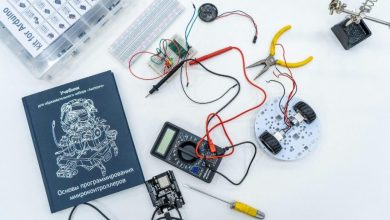Next-Gen Power Solutions: Technology at the Heart of Energy Transformation

Key Takeaways
- Automation enhances operational efficiency and reduces costs in energy services.
- Artificial Intelligence (AI) plays a pivotal role in predictive maintenance and grid management.
- Robotics and drones are transforming maintenance and inspection processes.
- Smart grids and automation enable more efficient energy distribution and consumption.
- Challenges include cybersecurity risks and the need for skilled personnel.
Table of Contents
- Enhancing Operational Efficiency
- AI in Predictive Maintenance
- Robotics and Drones in Energy Services
- Smart Grids and Automation
- Challenges in Implementing Automation
- Future Outlook
Across the globe, the energy sector is in the midst of a profound transformation driven by automation. Enhanced efficiency, greater reliability, and improved sustainability are no longer abstract goals, as they are results being realized through cutting-edge technologies. AI-powered platforms and automated systems streamline operations and enable real-time responsiveness to fast-changing demands. Businesses leveraging these tools, such as AI SEO services, are equipping themselves with actionable insights and smarter decision-making, which ultimately leads to more efficient, resilient energy services.
By integrating artificial intelligence, robotics, and smart automation, energy providers can offer services that are safer, less expensive, and more sustainable. These technologies do not just optimize processes; they fundamentally alter how energy is produced, distributed, and managed. Utilities are now deploying solutions that anticipate equipment failures before they occur and enhance control over complex energy networks, ensuring a steadier, cleaner power supply to communities and businesses. Smart automation also supports a rapid transition to renewable resources, overcoming the historical challenges of integrating solar and wind power into traditional grids. By monitoring the ebb and flow of distributed energy sources, automated systems help utilities maintain balance across the network. As a result, energy companies improve both the customer experience and their long-term profitability, going beyond simple operational upgrades to embrace transformational change. Adoption of these automated technologies is not without its hurdles, but the cost-saving and reliability advantages are setting new industry benchmarks. As these innovations become more widespread, the need for skilled operators and robust cybersecurity practices grows in parallel, highlighting the complexity of this new energy revolution.
Enhancing Operational Efficiency
Automation technologies are driving major gains in operational efficiency in the energy sector. Industry leaders, such as Honeywell and Siemens, are implementing AI-enabled controls that enable staff to optimize facility performance in real time, streamline complex workflows, and minimize human error. These innovations not only cut costs by reducing waste and downtime but also contribute to greener, more reliable energy delivery. By rapidly identifying inefficiencies and suggesting corrections, automation allows energy providers to focus on long-term value rather than short-term repairs or reactive maintenance.
AI in Predictive Maintenance
Artificial Intelligence is at the heart of predictive maintenance, fundamentally changing how energy companies look after their critical assets. Sophisticated AI algorithms analyze historical and real-time sensor data to predict equipment degradation and flag potential failures before they cause costly downtime. This translates into fewer unexpected breakdowns, smoother service delivery, and longer asset lifecycles. For instance, companies using predictive maintenance have reported significant savings on maintenance costs. As the complexity of energy infrastructure grows, predictive AI keeps networks healthy and investments optimized.
Robotics and Drones in Energy Services
Robotics and drones are revolutionizing inspection and maintenance, especially in hazardous or hard-to-reach locations. Drones equipped with thermal cameras and sensors can quickly inspect solar farms, transmission lines, or wind turbines for signs of wear. At the same time, ground-based robots handle repetitive tasks or operate in dangerous environments, such as deep-sea cable repairs or nuclear facilities. These technologies deliver high-precision results, reduce the need for human exposure to risk, and drastically minimize operational downtime. The Wall Street Journal showcased how global power companies are using drones and robots for faster, safer, and more cost-effective inspections, setting new industry standards in asset monitoring.
Smart Grids and Automation
Modern utilities are embracing automation in smart grid infrastructure, making energy delivery more flexible and adaptive. Smart grids use advanced metering, digital controls, and real-time communication networks to efficiently manage supply and demand. These systems can reroute power around outages, balance renewables with traditional sources, and automatically shift loads to minimize costs and emissions. Smart grid technology is key to a cleaner future, empowering communities to use more renewable energy and respond faster to changing consumption patterns. Government agencies like the U.S. Department of Energy are emphasizing investment in smart grids as a cornerstone for sustainable energy modernization.
Challenges in Implementing Automation
Despite the clear benefits, the transition to automated energy services presents significant challenges. One of the most pressing concerns is cybersecurity. Automated networks are prime targets for cyberattacks and require continual upgrades and rigorous security protocols. In addition, the shortage of skilled workers familiar with both legacy and next-generation technologies poses obstacles for many utilities. Overcoming these problems demands industry-wide investment in training, robust data protection measures, and collaborative effort to develop global security standards. Insights from Reuters illustrate how recent cyber-attacks on energy infrastructure have spurred companies and governments to double down on defense and upskilling initiatives.
Future Outlook
The future of energy services is increasingly automated and interconnected. As more companies adopt AI-driven management systems, deploy autonomous robots and drones, and digitize their infrastructure with smart grids, the energy sector is poised for even greater efficiency, reliability, and sustainability. With careful stewardship around cybersecurity and workforce development, automation will not only transform utilities but also pave the way for a greener, more resilient energy landscape. The era ahead promises a dramatic leap in how humanity powers its homes, businesses, and innovations, ensuring that energy remains affordable and dependable for generations to come.





